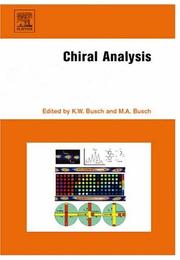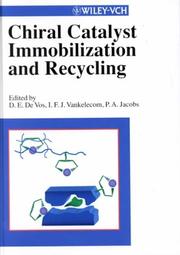| Listing 1 - 9 of 9 |
Sort by
|

ISBN: 1280751762 9786610751761 0080469280 0444516697 9780444516695 9780080469287 6610751765 9781280751769 Year: 2006 Publisher: Amsterdam ; Oxford : Elsevier,
Abstract | Keywords | Export | Availability | Bookmark
 Loading...
Loading...Choose an application
- Reference Manager
- EndNote
- RefWorks (Direct export to RefWorks)
Chiral Analysis covers an important area of analytical chemistry of relevance to a wide variety of scientific professionals. The target audience is scientific professionals with an undergraduate background in chemistry or a related discipline, specifically organic chemists, researchers in drug discovery, pharmaceutical researchers involved with process analysis or combinatorial libraries, and graduate students in chemistry. Chapters have been written with the nonspecialist in mind so as to be self-contained.* Broad coverage - spectroscopic and separation methods covered in a si
Chirality. --- Enantioselective catalysis. --- Chiral catalysis --- Enantioselective heterogeneous catalysis --- Heterogeneous asymmetric catalysis --- Heterogeneous catalysis --- Stereochemistry --- Symmetry (Physics) --- Enantiomers

ISBN: 3527299521 Year: 2000 Publisher: Weinheim : Wiley-VCH,
Abstract | Keywords | Export | Availability | Bookmark
 Loading...
Loading...Choose an application
- Reference Manager
- EndNote
- RefWorks (Direct export to RefWorks)
Enantioselective catalysis --- Chiral catalysis --- Enantioselective heterogeneous catalysis --- Heterogeneous asymmetric catalysis --- Heterogeneous catalysis --- Enantioselective catalysis. --- Asymmetric synthesis --- Catalysis, heterogeneous --- Catalyst supports --- Catalysts --- Chirality --- Epoxidation catalysts --- Hydrogenation catalysts
Book
ISBN: 9780444640277 9780444640284 0444640282 0444640274 Year: 2018 Publisher: Amsterdam, Netherlands : Elsevier,
Abstract | Keywords | Export | Availability | Bookmark
 Loading...
Loading...Choose an application
- Reference Manager
- EndNote
- RefWorks (Direct export to RefWorks)
Spectrometric and optical chemical analysis --- Chirality. --- Enantioselective catalysis. --- Chiral catalysis --- Enantioselective heterogeneous catalysis --- Heterogeneous asymmetric catalysis --- Heterogeneous catalysis --- Stereochemistry --- Symmetry (Physics) --- Enantiomers --- Chirality --- Enantioselective catalysis
Book
ISBN: 1617281018 9781617281013 9781616686802 1616686804 Year: 2011 Publisher: New York : Nova Science Publishers,
Abstract | Keywords | Export | Availability | Bookmark
 Loading...
Loading...Choose an application
- Reference Manager
- EndNote
- RefWorks (Direct export to RefWorks)
Asymmetric synthesis. --- Enantioselective catalysis. --- Ligands. --- Nitrogen compounds. --- Chemicals --- Coordination compounds --- Chiral catalysis --- Enantioselective heterogeneous catalysis --- Heterogeneous asymmetric catalysis --- Heterogeneous catalysis --- Asymmetric induction --- Induction, Asymmetric --- Synthesis, Asymmetric --- Asymmetry (Chemistry) --- Organic compounds --- Synthesis
Book
ISBN: 012417115X 012417034X 9780124170346 Year: 2014 Publisher: Waltham, [Massachusetts] ; Amsterdam, The Netherlands : Academic Press,
Abstract | Keywords | Export | Availability | Bookmark
 Loading...
Loading...Choose an application
- Reference Manager
- EndNote
- RefWorks (Direct export to RefWorks)
Key Chiral Auxiliary Applications, Second Edition is a detailed compilation of chiral auxiliary applications organized by type of transformation. Continuing from the most important and relevant auxiliaries described in its predecessor, the three-volume set Compendium of Chiral Auxiliary Applications (2001), as well as advances in the field, the book provides a vital and timely resource for chemists in the field. Each reaction class includes a series of tables and graphical abstracts of real reactions from the literature and patents to enable easy review and comparison of resul
Asymmetric synthesis. --- Enantiomers. --- Enantioselective catalysis. --- Asymmetric synthesis --- Enantiomers --- Chemistry --- Physical Sciences & Mathematics --- Organic Chemistry --- Antipodes, Optical --- Enantiomorphs --- Isomers, Mirror-image --- Mirror-image isomers --- Optical antipodes --- Optical isomers --- Chirality --- Chiral catalysis --- Enantioselective heterogeneous catalysis --- Heterogeneous asymmetric catalysis --- Heterogeneous catalysis --- Asymmetric induction --- Induction, Asymmetric --- Synthesis, Asymmetric --- Asymmetry (Chemistry) --- Organic compounds --- Synthesis
Book
ISBN: 9401780501 9048138647 9048138655 Year: 2011 Publisher: Dordrecht [Netherlands] : Springer,
Abstract | Keywords | Export | Availability | Bookmark
 Loading...
Loading...Choose an application
- Reference Manager
- EndNote
- RefWorks (Direct export to RefWorks)
Organocatalysis has emerged as one of the hot topics in organic chemistry in recent years, as confirmed by the rapid-growing interest that researchers have shown in this field. Enantioselective Organocatalyzed Reaction Volume I and II provides a critical review of the state-of-the-art developments in Organocatalysis, with a special focus on the asymmetric transformation that it enables. These volumes, written by leading experts in the field, discuss a broad range of synthetic transformations and offer an up-to-date coverage of organocatalyzed reactions such as: • Conjugate addition; • Aldol addition; • Oxidation; • Reduction; • Cycloaddition; • Mannich reaction; • Asymmetric f untionalization; • Enantioselective protonation; • General aspects of asymmetric cyclization; • Asymmetric desymmetrization processes. By presenting a complete panorama of the use of organocatalysts in organic reaction, Enantioselective Organocatalyzed Reaction will help the global audience of scientists engaged in this area of research to develop new catalysts as well as new fields of applications in organic synthesis.
Asymmetric synthesis. --- Catalysis. --- Chirality. --- Enantioselective catalysis. --- Nucleophilic reactions. --- Chemistry --- Physical Sciences & Mathematics --- Physical & Theoretical Chemistry --- Biochemistry --- Chiral catalysis --- Enantioselective heterogeneous catalysis --- Heterogeneous asymmetric catalysis --- Chemistry. --- Organic chemistry. --- Organic Chemistry. --- Heterogeneous catalysis --- Chemistry, Organic. --- Activation (Chemistry) --- Chemistry, Physical and theoretical --- Surface chemistry --- Organic chemistry
Book
ISBN: 3642227481 364222749X Year: 2012 Publisher: Berlin : Springer,
Abstract | Keywords | Export | Availability | Bookmark
 Loading...
Loading...Choose an application
- Reference Manager
- EndNote
- RefWorks (Direct export to RefWorks)
Giovanni Poli, Guillaume Prestat, Frédéric Liron, Claire Kammerer-Pentier: Selectivity in Palladium Catalyzed Allylic Substitution.- Jonatan Kleimark and Per-Ola Norrby: Computational Insights into Palladium-mediated Allylic Substitution Reactions.- Ludovic Milhau, Patrick J. Guiry: Palladium-catalyzed enantioselective allylic substitution.- Wen-Bo Liu, Ji-Bao Xia, Shu-Li You: Iridium-Catalyzed Asymmetric Allylic Substitutions.- Christina Moberg: Molybdenum- and Tungsten-Catalyzed Enantioselective Allylic Substitutions.- Jean-Baptiste Langlois, Alexandre Alexakis: Copper-catalyzed enantioselective allylic substitution.- Jeanne-Marie Begouin, Johannes E. M. N. Klein, Daniel Weickmann, B. Plietker: Allylic Substitutions Catalyzed by Miscellaneous Metals.- Barry M. Trost, Matthew L. Crawley: Enantioselective Allylic Substitutions in Natural Product Synthesis.
Chemistry --- Physical Sciences & Mathematics --- Physical & Theoretical Chemistry --- Organic Chemistry --- Organometallic chemistry. --- Transition metals. --- Enantioselective catalysis. --- Organic compounds --- Synthesis. --- Chemistry, Organic --- Chemistry, Synthetic organic --- Organic synthesis (Chemistry) --- Synthetic organic chemistry --- Chiral catalysis --- Enantioselective heterogeneous catalysis --- Heterogeneous asymmetric catalysis --- Transition elements --- Chemistry, Organometallic --- Metallo-organic chemistry --- Synthesis --- Chemistry. --- Organic chemistry. --- Catalysis. --- Organometallic Chemistry. --- Organic Chemistry. --- Heterogeneous catalysis --- Metals --- Chemistry, Organic. --- Activation (Chemistry) --- Chemistry, Physical and theoretical --- Surface chemistry --- Organic chemistry --- Organometallic chemistry .
Book
ISBN: 3319749145 3319749137 Year: 2018 Publisher: Cham : Springer International Publishing : Imprint: Springer,
Abstract | Keywords | Export | Availability | Bookmark
 Loading...
Loading...Choose an application
- Reference Manager
- EndNote
- RefWorks (Direct export to RefWorks)
This thesis discusses the use of asymmetric organic catalysis for the direct enantioselective synthesis of complex chiral molecules, and by addressing the many aspects of both vinylogy and atropisomerism, it appeals to researchers and scholars interested in both areas. Organocatalysis is a relatively modern and “hot” topic in the chemical community; it is constantly expanding and its use has been extended to interesting areas like vinylogous reactivity and atropisomerism. Vinylogous systems are very important for their synthetic applications but also pose a number of challenges, the most notable of which are their reduced reactivity and the reduced stereocontrol at these positions. On the other hand, atropisomeric systems are even more important because of the huge potential they have as drugs, ligands and catalysts. Chemists have only recently “recognized” the importance of these two areas and are focusing their efforts on studying them and the challenges they pose. This thesis offers an extensive introduction on the general aspects of chirality and organocatalysis and an equally extensive experimental section that allow nonexperts to understand the discussion section and reproduce the experiments.
Enantioselective catalysis. --- Asymmetric synthesis. --- Chemistry. --- Organic chemistry. --- Medicinal chemistry. --- Catalysis. --- Organic Chemistry. --- Medicinal Chemistry. --- Asymmetric induction --- Induction, Asymmetric --- Synthesis, Asymmetric --- Asymmetry (Chemistry) --- Organic compounds --- Chiral catalysis --- Enantioselective heterogeneous catalysis --- Heterogeneous asymmetric catalysis --- Heterogeneous catalysis --- Synthesis --- Chemistry, Organic. --- Biochemistry. --- Biological chemistry --- Chemical composition of organisms --- Organisms --- Physiological chemistry --- Biology --- Chemistry --- Medical sciences --- Organic chemistry --- Activation (Chemistry) --- Chemistry, Physical and theoretical --- Surface chemistry --- Composition --- Chemistry, Medical and pharmaceutical --- Chemistry, Pharmaceutical --- Drug chemistry --- Drugs --- Medical chemistry --- Medicinal chemistry --- Pharmacochemistry
Book
ISBN: 3540877568 3540877576 Year: 2009 Publisher: Berlin : Springer,
Abstract | Keywords | Export | Availability | Bookmark
 Loading...
Loading...Choose an application
- Reference Manager
- EndNote
- RefWorks (Direct export to RefWorks)
In order to meet the ever-increasing demands for enantiopure compounds, heteroge- ous, homogeneous and enzymatic catalysis evolved independently in the past. Although all three approaches have yielded industrially viable processes, the latter two are the most widely used and can be regarded as complementary in many respects. Despite the progress in structural, computational and mechanistic studies, however, to date there is no universal recipe for the optimization of catalytic processes. Thus, a trial-and-error approach remains predominant in catalyst discovery and optimization. With the aim of complementing the well-established fields of homogeneous and enzymatic catalysis, organocatalysis and artificial metalloenzymes have enjoyed a recent revival. Artificial metalloenzymes, which are the focus of this book, result from comb- ing an active but unselective organometallic moiety with a macromolecular host. Kaiser and Whitesides suggested the possibility of creating artificial metallo- zymes as long ago as the late 1970s. However, there was a widespread belief that proteins and organometallic catalysts were incompatible with each other. This severely hampered research in this area at the interface between homogeneous and enzymatic catalysis. Since 2000, however, there has been a growing interest in the field of artificial metalloenzymes for enantioselective catalysis. The current state of the art and the potential for future development are p- sented in five well-balanced chapters. G. Roelfes, B. Feringa et al. summarize research relying on DNA as a macromolecular host for enantioselective catalysis.
Enantioselective catalysis --- Asymmetric synthesis --- Physical & Theoretical Chemistry --- Organic Chemistry --- Chemistry --- Physical Sciences & Mathematics --- Enantioselective catalysis. --- Asymmetric synthesis. --- Asymmetric induction --- Induction, Asymmetric --- Synthesis, Asymmetric --- Chiral catalysis --- Enantioselective heterogeneous catalysis --- Heterogeneous asymmetric catalysis --- Chemistry. --- Inorganic chemistry. --- Organometallic chemistry. --- Medicinal chemistry. --- Catalysis. --- Biochemistry. --- Organometallic Chemistry. --- Biochemistry, general. --- Inorganic Chemistry. --- Medicinal Chemistry. --- Asymmetry (Chemistry) --- Organic compounds --- Heterogeneous catalysis --- Synthesis --- Chemistry, Organic. --- Chemistry, inorganic. --- Inorganic chemistry --- Inorganic compounds --- Biological chemistry --- Chemical composition of organisms --- Organisms --- Physiological chemistry --- Biology --- Medical sciences --- Activation (Chemistry) --- Chemistry, Physical and theoretical --- Surface chemistry --- Organic chemistry --- Composition --- Organometallic chemistry . --- Chemistry, Medical and pharmaceutical --- Chemistry, Pharmaceutical --- Drug chemistry --- Drugs --- Medical chemistry --- Medicinal chemistry --- Pharmacochemistry --- Chemistry, Organometallic --- Metallo-organic chemistry --- Chemistry, Organic
| Listing 1 - 9 of 9 |
Sort by
|

 Search
Search Feedback
Feedback About UniCat
About UniCat  Help
Help News
News